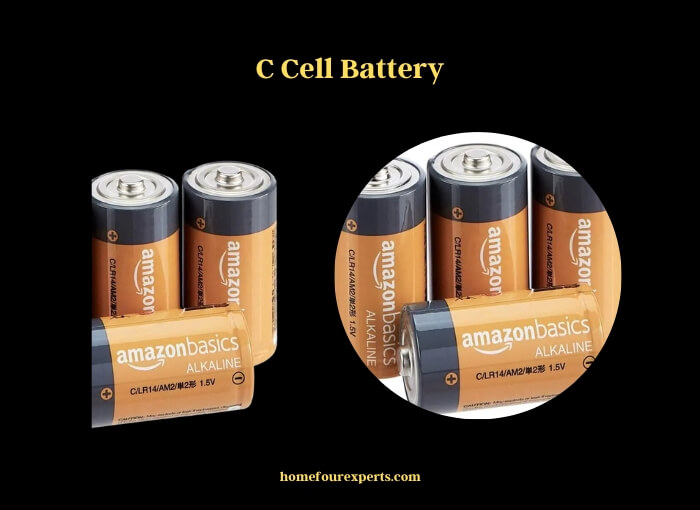Whether it’s a portable home item, toys, or an air mattress pump there use C Cell batteries. C batteries are not handy & common like AA batteries or AAA batteries. In terms of power longevity, the C type of battery comes across to have advantages. It is also known as LR14 and R14 batteries with different names.
If you wish to know more about this battery, you will look at the full article. In this article, we accumulate info from basic to a depth of the C Cell batteries.

What is a C Type of Battery?
C-type battery is one of the popular dry cell batteries, commonly used in the most portable devices. Dry cells operate with minimal internal moisture. AA and AAA are other common & outstanding dry cell battery sizes.
The size of the double-A and triple-A batteries are smaller than the C dry cell batteries. Plus, they no longer have a life span like a C battery. But, C-size batteries are narrowly smaller than D batteries.
The C type of battery gives a long-lasting and precise charge for devices, whether they need a medium or high power consumption. Their size is the same although capacity and voltage are different.
So, you can use the C batteries for your torches, toys, cameras, radios, intruder alarms, some musical instruments, or similar. But, for your small watch, you would turn into cr2430 type of batteries. C batteries are nominated by the International Electrotechnical Commission (IEC). They are also familiar with the R14 or LR14 batteries.
C Size Batteries Dimensions and Specifications
Most of the C-type batteries are designed to the same physical size and standard to make sure ultimate compatibility with accessories and devices. These cylindrical batteries’ physical dimensions are (Height×Diameter) 50.0mm × 26.2mm or ~1.9685 inches in height and ~1.0315 inches in diameter.
You know, C batteries are quite larger than A batteries and AA batteries. So, the physical dimensions of the A batteries are
50.0 x 17.0 mm and AA batteries are 50.5 x 14.5 mm. Sometimes C batteries can be displaced by these kinds of cells adopting the plastic size adapter. Other labels of the C batteries are 14D batteries, 14A batteries, MN1400 batteries, MX1400 batteries, 343 batteries, U11 batteries, LR14 batteries, R14 batteries, etc.
Fortunately, 26500 batteries come with the same physical dimensions as the C batteries like 50.0 x 26.0 mm, where diameter 26.0 mm and height 50.0 mm. Believe it or not, this height is also similar to the 25500 battery height. But, their diameter is slightly smaller, only one mm lower than the 26500 battery’s diameter.
What Are the Common Uses for C Cell Batteries
1. Remote controls
2. Toys
3. Flashlights
4. Smoke detectors
5. Wall clocks
6. Calculators
7. Digital thermometers
8. Blood pressure monitors
9. Portable electronic devices
10. Automotive electronic devices
C Cell Batteries Chemistries
C cell batteries come with different capacities, voltages, and chemistry. Nickel Cadmium, Nickel Metal Hydride, Lithium, and Alkaline batteries are common types, as explored in the following sections:
1. Nickel Cadmium (NiCd)
Nickel-cadmium C cell batteries are capable of producing huge currents so that their discharge rate is fairly high. But, when you compare with the Nickel-Metal Hydride batteries, these have limited charging or discharging rates. The nominal voltage of the rechargeable C-type battery is 1.2V. NiCd batteries’ downside is their high memory effect and environmental effect of cadmium.
2. Nickel Metal Hydride (NiMH)
NiMH C batteries have a lot of features and advantages. The most important features are cadmium/mercury-free, better capacity, good shelf life, and low self-discharge rate. This type of rechargeable battery is eligible to receive a large number of charging or discharging cycles.
The standard NiMH C battery’s nominal capacity is from 4.0 to 6.0 Ah and nominal voltage is 1.2 volts. High drain NiMH C size batteries can manufacture between 60 Amps and 70 Amps or more depending on the models. But, low drain models feature a large number of capacities.
3. Alkaline
Another common C cell batteries are non-rechargeable Alkaline batteries. These types of batteries come with longer shelf life from 7 to 10 years, sometimes more than 10 years. Other characteristics are nominal capacity between 6.0 Ah and 8.0Ah where average storage capacity is up to 8000 mAh. And, the nominal voltage of 1.5 volts. Suitable for use in portable devices like toys, LED flashlights, etc.
4. Zinc-Carbon
Some C cell batteries use zinc-carbon chemistry. They are cheaper than other C types of batteries. On average, nominal capacity is 3.0 to 4.0 Ah range, usually holding up to 3800 mAh. Another feature is the nominal voltage of 1.5 volts. The shelf life is low from 3 to 5 years.
5. Lithium
Lithium non-rechargeable batteries have a low-self discharge rate but a large capacity perhaps 8.0 to 10.0 Ah. Low temperature is not a problem for these C-size batteries.
Our Recommendations
There are several C Cell batteries in the market. We share a cross-reference chart of some popular brands.
| Models | Brands | Cell Composition | Voltage | Unit Count |
| Energizer Max 9V Batteries | Energizer | Alkaline | 9 Volts | 4.0 Count |
| AmazonBasics 4 Pack C Cell All-Purpose | Amazon Basics | Alkaline | 1.5 Volts | 4.0 Count |
| Duracell – CopperTop C Alkaline Batteries | Duracell | Alkaline | 1.5 Volts | 8 Count |
| Rayovac Fusion C Batteries | Rayovac | Alkaline | —- | 4 Count |
| Panasonic Heavy Duty C Batteries | Panasonic | Alkaline | 1.2 Volts | 24.0 Count |
From the chart, Amazonbasics 4 Pack C Cell All-Purpose Alkaline Batteries and Duracell – CopperTop C Alkaline Batteries feature 1.5 volts nominal voltage. This 1.5 volt is standard and suitable for use in daily household items.
You can use the 1.5 Volts C Batteries in remote controls, clocks, radios, torches, toys, and other similar applications. Alternatively, 3 Volt C Cell batteries are well known to use the normal drain applications. Perfect for smart gas meters, oil tank level monitoring, or similar.
Ultimately, C-size battery capacity and voltage are dependent on the battery chemistry along with discharge conditions.
The nominal capacity of the Alkaline C Cell batteries is up to 8000 mAh. On the other hand, NiMH rechargeable batteries have a storage capacity approx 6000 mAh. Zinc-carbon C batteries can hold up to 3800 mAh, very low capacity.
Are There Different Types of C Batteries?
Yes, there are two major types of C batteries. They are –
- Rechargeable
- Non-rechargeable
Both C battery types have some similarities and differences. Where rechargeable C batteries require recharging hundreds of times until the battery is fully charged. So, their charging process is pretty sensitive. It is also important to use the appropriate charger depending on the brand. These batteries can appear pre-charged, but not always.
The unique thing is the rechargeable batteries containing different chemicals. That’s why it will stock extra electrons. During the charging time, the reservoirs can be restored by the battery heap.
Remember, these batteries allow you to use separate chargers considering the chemistry compatibility, plug types, and dimensions. Several chemistries C Cell rechargeable batteries are available in the market. For example, NiMH (nickel-metal hydride) batteries, Li-ion (lithium-ion), NiCd (nickel-cadmium), etc. NiCd is also known as NiCad or Ni-Cads.
Unlike, non-rechargeable batteries don’t require any charge because they are formulated to be charged fully. If you try to charge them, they can overheat, rupture, and sometimes explode without any signal. Non-rechargeable C cell batteries are not qualified to store extra electrons. After using the battery for a long time, their stored electrons have been drained.
Frequently Asked Questions
What Does C Mean in Batteries?
C indicates the battery’s current which means charge rate and discharge rate. If the completely charged battery has a nominal capacity of 10 Ah, it is capable of providing 10 Amps per hour.
Are C Batteries Being Phased Out?
Depending on the battery chemistry, they can be phased out, especially for the NiCd batteries because of their environmental impact.
What is the Main Difference Between AA AAA C and D Batteries?
The main difference between AAA, AA, C, D batteries is physical size although the voltage is pretty similar like 1.5 volts. When you compare their voltage and current, the D-size battery can provide further current than the AA, AAA, and C-size battery.
Are C Batteries the Same as R14 Batteries?
The straightforward answer is yes. C size batteries are known as LR14, R14, MX1400, MN1400, and more.
Conclusion
So, we reach the end of the article. You already know the features, specifications, and five best recommended C Cell batteries. These batteries are affordable and user-friendly but not so much cheaper. You would end up paying more & worrying further about the environment if you use the more cheap batteries. Among those, the best overall pick is Duracell CopperTop C Alkaline C Cell Batteries.
Relevant Resources:
About This Writer

Hi, I am responsible for the 'Homeowners Power Solutions' category. My name is Liam Jaxon and a licensed technician with 7 years of experience in vehicle batteries, electrical gadgets, and home appliances. My working experience in different residential & light commercial electrical sectors and the automobile industry helped to acquire vast knowledge in this industry.